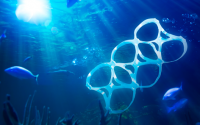Marine anthropogenic litter and microplastics
- Date
- 31 Jan 2017
- Start time
- 7:30 PM
- Venue
- Tempest Anderson Hall
- Speaker
- Dr Lucy Woodall

Marine anthropogenic litter and microplastics
by Dr Lucy Woodall, University of Oxford
Marine litter is an insidious problem that has been found across the globe from pole to pole, on remotest beaches and down to the deepest depths of the ocean. This issue has featured in many media stories and documentaries over recent years, but do these accounts represent the issues correctly? Are there really islands of rubbish in the middle of the sea? Dr Woodall is a marine biologist; she led research that revealed the ubiquity of microplastics in the deep-sea and has also uncovered patterns of seabed debris. In this talk she will present the sources of marine litter and especially those of microplastics, highlight some of the impacts of these pollutants and discuss the invisibility of marine litter.
[picture credit: D. Moore]
Member’s report
Dr Woodall’s own researches are into microplastics; tiny particles of plastic that infiltrate even deep sea sediments. To study these requires ocean-going research vessels, a variety of specialized equipment, and the ability to spend long periods at sea. A maritime background that includes time as a navigating officer in the Merchant Navy (not to mention a period helping with the re-rigging of Cutty Sark) has clearly prepared Dr Woodall for this. Her purpose-built on-board laboratory is built in to a shipping container. Its construction and fittings use as little plastic as possible, to avoid accidental contamination of samples; and any plastic that has to be used is fully characterized so that it can be identified and, if necessary, discounted from samples.
Next to the laboratory on deck is a similar container housing the pilots who control the Remote Operating Vehicle (ROV) that takes the actual samples, with Dr Woodall at their shoulder dictating what should be sampled: as she describes it, her ‘favourite kind of shopping’.
The simple conclusion in that microplastic contamination is everywhere: in the tissues of fish and other marine life – almost all of the fish we eat contain microplastics – as well as in the sediments of the deep sea. Evidence of harm is sparse. In some cases microplastic accumulation has been shown to adversely affect animals, in others it seems to have little or no effect. However, as toxins such as heavy metal contaminants can attach to microplastic particles, there is no cause from complacency.
Once in the sea, plastic contamination is impossible to get rid of, particularly microplastic particle accumulation in sediments. The aim must be to reduce the quantities that enter the sea. Plastic contamination comes from deliberate and accidental dumping, from runoff from the land and outflows, from the breakdown of wrecks. All of these sources could, in principle, be reduced in magnitude. Attention needs also to be given to changing our usage of plastics, and converting, as far as possible, to alternative materials, such as bioplastics, that do not break down into insidious microparticles. The problem is a global one, and it is encouraging that it is being considered at a global level, not least at the recent Davos World Economic Forum.
Peter Hogarth